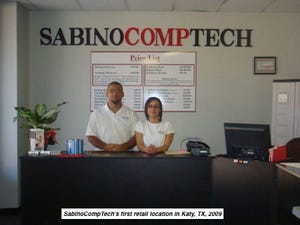Evolution in Real Time: Angel & Nancy Sabino, Partners in Transformation
In 2008, when they were both 22 years old, Nancy and Angel Sabino started their own IT services firm in Katy, Texas, a suburb of Houston. The Great Recession had just hit, and they had a three-year-old child with another on the way. And though they didn’t know it yet, the Sabinos had entered the channel during a time of upheaval, when traditional business models were being turned upside down by cloud and mobile technologies, and the IT industry was diving headfirst into the Digital Transformation.

In 2008, when they were both 22 years old, Nancy and Angel Sabino started their own IT services firm in Katy, Texas, a suburb of Houston. The Great Recession had just hit, and they had a three-year-old child with another on the way. And though they didn’t know it yet, the Sabinos had entered the channel during a time of upheaval, when traditional business models were being turned upside down by cloud and mobile technologies, and the IT industry was diving headfirst into the Digital Transformation.
SabinoCompTech began as a break/fix shop specializing in small business IT needs. In 2009, they opened a retail location to service residential customers, thinking that it would improve their much needed cash flow. But they soon discovered that the margins were so narrow that they had to scramble for enough business volume every month just to break even.
“The best way to put it is the Wal-Mart Effect,” says Angel. “You need a lot of crappy stuff in order to make it work.”
The Sabinos felt as if they were in a hamster wheel of low-effort yet low-cost services. Their residential business was at complete odds with their business services, where they pushed themselves to provide the best quality work they could. In order to scale the residential side, they calculated, they would need to start hiring under-qualified technicians and resigning themselves to providing substandard work.
at complete odds with their business services, where they pushed themselves to provide the best quality work they could. In order to scale the residential side, they calculated, they would need to start hiring under-qualified technicians and resigning themselves to providing substandard work.
“That’s not something we wanted to do, especially since we knew we were trying to also support the business side of it. Running both companies at the same time proved to be incredibly difficult. One side was saying, ‘Hey, you need quality, you need to stand by your morals and business pride,’” says Angel. “On the other side, we were fighting against competitors who were just reloading computers constantly because it was the cheapest, easiest thing to do.”
Time for a change
Something needed to give. In September 2016, Nancy was accepted into the Goldman Sachs 10,000 Small Businesses program, and almost immediately, everything changed. The Sabinos realized that the ecosystem they thought they’d created, where one side of the business fed the other, didn’t exist. Instead, the residential market was taking up more resources than it paid for. It was clear they needed to shut down that side of their business.
Simultaneously, Nancy was learning at the Goldman Sachs class about the benefits of a monthly services model. “After the first class, we decided to transition over to an MSP model business and close the residential side completely,” she says. “We did it in 30 days. We closed the residential business, moved from the retail location to an office and completely redesigned our processes, our service offering and our branding.”
The Sabinos took a hard look at their client list and concluded they had three broad types of clients with three sets of IT needs. In order to be able to cover all of them, they devised three different monthly subscription packages. Because they’d developed these replicable “solutions in a box,” it became surprisingly easy to scale.
They push to get every single one of their customers onto a subscription model, even if it’s just on a single user level. For those customers, they offer a starter package in which they treat a small customer’s computer as they would a larger customer’s server. They manage programs and services for these one and two-person shops just as they would for bigger companies; they just do it on the individual computer. The ultimate goal is to get the customer on a monthly subscription. They’re okay with starting small, knowing that they’ll be able to scale their offerings as the client’s business grows.
“We never really wanted to get rid of the small company,” says Angel. “Small companies grow into big companies—and they need technology to do that.”
Taking the leap
Before they made the transition, the Sabinos approached every client they wanted to keep and moved them into one of the three packages. It saw them through the uncertainty of closing the residential business and fully transitioning to an MSP.
But they warn other partners looking to make the transition from one-time sales to a subscription model to prepare themselves to lose some customers. Not every client is a fit, and no matter how much you like a customer, there will be times when it’s best for the business to part ways. If a customer won’t or can’t come along for the ride, it’s best to part amicably than drag it out and let resentment build on one or both sides.
It wasn’t long before the gamble paid off, and SabinoCompTech began to bring in solid monthly recurring revenue. But it wasn’t as easy as it might sound, they say. During the time they made this transition, they had two small children. Nancy was enrolled in the Goldman Sachs program, they opened a new office location and moved into a new house. “I think we stopped sleeping,” says Nancy.
But it wasn’t as easy as it might sound, they say. During the time they made this transition, they had two small children. Nancy was enrolled in the Goldman Sachs program, they opened a new office location and moved into a new house. “I think we stopped sleeping,” says Nancy.
In the end, though, it was worth it. Nancy says their employees are happier with their work and their clientele, and customers are happier because the services are more proactive. “We’re bringing problems to them ahead of time, and then we’re also going through and meeting with them on a more business level, looking at how we can increase their efficiencies and save them money in the long run. They’re very happy when it comes to all that.”
The continuing evolution
The Sabinos aren’t resting on their laurels. They’re continuing to revisit their service models and tweak their offerings. They’re currently putting elements in place to evolve from an MSP to a TSP, or total service provider. They’re beginning to tackle more sophisticated sales and marketing strategies and reevaluate how their packages are put together.
“I can tell you it’s been a journey for us, and a very personal one for me,” says Nancy. “This has been so exciting for us. I like to say that I know something will be good because I can feel it in my bones and in my soul—and I have that feeling for the direction we’re going.”
Look for our next installment of Partners in Transformation, where the Sabinos talk about cultivating a vertical focus and their next leap of faith.
Is your business undergoing an evolution as you navigate the digital transformation in the channel? Tell us about it in the comments below, or click here to email The VAR Guy’s Editor-in-Chief, Kris Blackmon, for your chance to be featured on the site.
About the Author
You May Also Like


